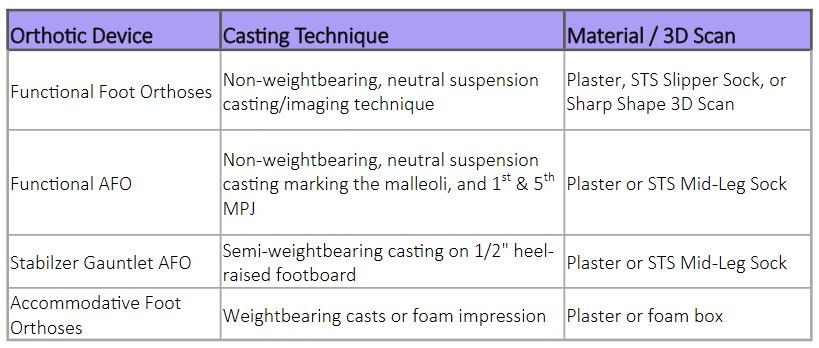Quality Orthoses Begin with Quality Casts
Negative cast quality is a key factor in determining the effectiveness of orthoses in your clinical outcomes. Functional and accommodative orthoses require different casting techniques. ProLab’s standards for casting are supported by the literature and are part of our evidence-based approach to orthotic therapy. The table below outlines the requirements for each type of orthotic device.

Why Do We Require Casts or Scans for Functional Foot Orthoses?
The short answer is better outcomes for your patients. By definition, a functional orthosis is one in which the forefoot is balanced to the perpendicular axis of the rearfoot in the frontal plane when the foot is held non-weightbearing in subtalar neutral with the midtarsal joint locked. The negative cast or scan must capture the posterior heel as well as the plantar aspect of the foot for our skilled technicians to balance an orthosis in the frontal plane. Without this balancing, the orthosis is providing only a simple arch support.
Several studies have demonstrated that foam box impressions capture excessive forefoot varus relative to non-weightbearing impressions. This leads to excessive varus in the orthosis, and excessive varus in the orthosis can exacerbate certain pathologies, such as functional hallux limitus. This is one reason why we require a non-weightbearing, neutral suspension casting technique for functional orthoses.This standard is based on two significant studies:
- A 1989 Northern Arizona University study showed that having any weight on the foot during the casting or imaging process resulted in an orthotic shape that has been shown to cause pain in the big toe joint and to increase tension on the plantar fascia.1,2
- A 2002 study from the Joiner Center for Sports Medicine at the University of Delaware showed that weightbearing casting resulted in abnormal force under the big toe joint.3 This has been shown to result in the production of an orthotic that does not work well at reducing the forces that lead to common foot problems such as bunions, big toe joint pain, heel pain, arch pain, plantar fasciitis and other conditions.1 Non-weightbearing casting was recommended as the most reliable and valid method for making custom foot orthotics.3
References
1. McPoil, TG; Schmit, D. Comparison of three methods used to obtain a neutral plaster foot impression. Phys Ther. 69(6):448-52, 1989
2. Roukis TS, Scherer PR, Anderson CF. Position of the first ray and motion of the first metatarsophalangeal joint. J Am Podiatr Med Assoc. 86(11):538-46, 1996
3. McClay-Davis I, Laughton C, Williams, DS. Comparison of four methods of obtaining a negative impression of the foot. J Am Podiatr Med Assoc. 92(5):261-8, 2002
Watch these Casting Videos